
Manuel Göttsching was born on 9th September 1952. As a child he studied classical guitar and later studied with Swiss avant-garde composer Thomas Kessler.
In the late 1960s Manuel listened to Jimi Hendrix, Eric Clapton and Peter Green and took their work to another place with his intense freeform jamming as part of the awesome three piece band Ash Ra Tempel who released their self-titled debut album in 1971. A.R.T. were joined by icon Timothy Leary for their third album, Seven Up (1972). Göttsching went on to play in the jam sessions that would be released under the band name Cosmic Jokers. Their albums, all released in 1974, represent some of the greatest space rock ever committed to tape.
Absorbing the sounds of the minimalist composers Terry Riley and Steve Reich and then incorporating this into his own style, Göttsching made a series of masterful records. Inventions for Electric Guitar (1975) deserves a place alongside the most innovative LPs in the history of rock music. Everything was played with guitar and tape effects but many think that sequencers and synthesizers were used. New Age of Earth (1976) was another masterpiece but this time keyboards were the focus. Sunrain is quite simply one of the most stunning instrumentals of all time. Blackouts (1977) fused the sounds of the previous couple of albums and is in many ways the quintessential Manuel Göttsching record, as it incorporated cutting edge electronics, rock guitar and hypnotic patterns of notes in a style favoured by the minimalists. Although the previous two long players had been released using the name Ashra they were essentially Göttsching solo efforts. Joined by Lutz Ulbrich and Harald Grosskopf, Ashra became a band for the next two albums: the meticulously crafted Correlations (1979) and the eclectic and rewarding Belle Alliance (1980).
Off the back of touring with Klaus Schulze in 1981, Manuel recorded an improvisational piece for guitar and electronics lasting one hour. Unsure of what to do with this unusual and seemingly perfect piece of music he stored it for three years before its eventual release in 1984 as E2-E4. Whilst Manuel was recording Tropical Heat, a sunny musical travelogue with Ashra in 1985/86 (released in 1991) and Walkin’ the Desert, another Ashra recording to accompany a performance at the Berlin Planetarium in 1989, E2-E4 was gaining a reputation as a New York club classic. The dance music community was also embracing the record in Ibiza and across Europe. Suddenly an improvised piece for electronics and guitar was being hailed as the beginning of contemporary dance music. E2-E4 certainly sounded closer to techno than anything recorded by Kraftwerk or any of Göttsching’s early musical contemporaries. The belated success of the record was well deserved as it was both startling futuristic for its time and a true classic.
In 1997 Ashra reunited for a series of concerts that were later documented by the albums @shra and @shra vol. 2 (both recorded live in Japan). With younger musician and DJ Steve Baltes on board Ashra’s music was imaginatively and stylishly reinvented for the techno generation. 1997 also saw Göttsching compose and record music for an installation of 34 mirrors by artist Mercedes Engelhardt, titled R.S.V.P. This smooth, electronic, pastoral piece was later released in 2005 as Die Mulde.
The Ash Ra Tempel duo of Manuel Göttsching and Klaus Schulze reunited to record new studio material in 1998, which would later be released in 2000 as Friendship. When asked by Julian Cope to play at the Royal Festival Hall in 2000 as part of the Cornucopia festival, Manuel in turn invited Schulze and their performance was released as Gin Rosé. The new Ash Ra Tempel recordings showed musical maturity, with slow burning, atmospheric pieces, a far cry from the molten intensity of the debut album.
In late 2002 Manuel was commissioned to write and perform music for the filmfest Braunschweig. The following year he delivered a series of compositions to accompany F.W. Murnau’s 1921 silent film Schloss Vogelöd (Haunted Castle). The result was a suitably sombre, yet addictive mixture of electronic pieces, compositions for chamber musicians accompanied by electronics and musical vignettes for chamber orchestra alone. First performed in 2003, much of the music was released in 2005 under the title Concert for Murnau.
In 2007 Göttsching released his first live album Live at Mount Fuji, a satisfying collection of reworked music, also featuring the new and exclusive track Trunky Groove. As an appealingly unpredictable musical career continues we can only wait and guess at what may come next. Manuel: your move……









No comments:
Post a Comment